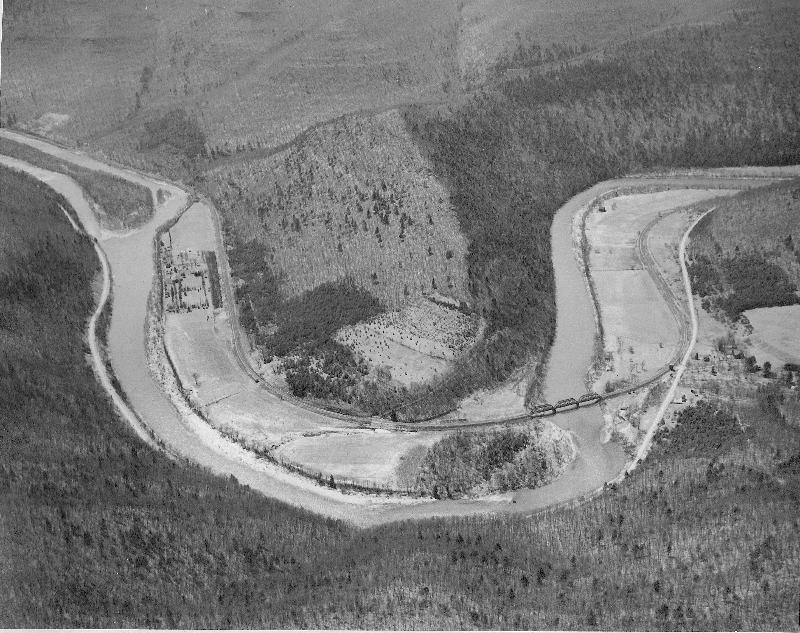Some of the very earliest sawmills in the Pine Creek Valley included one built in 1793 at the mouth of Gamble’s Run just above present-day Torbert Village, Captain Christian Stake’s 1792 mill less than a mile up Little Pine Creek from Waterville, and Jacob Tomb’s at the mouth of Slate Run in 1792.
Early notable farmers included Henry B. Tomb (1797-1883) on his 900 acres in Tombs Run, Thomas Ramsey (1742-1813) on his 200 acres in Ramsey, and Michael Campbell (1794-1881) on his 50 acres about one mile above Cammal.
Perhaps the two most famous hunters and trappers were George Bonnell (1787-1879) and Philip Tome (1782-1855). Bonnell lived about three miles below Slate Run. Tome, originally living at Slate Run, wrote a popular book published in 1854, entitled Pioneer Life or Thirty Years a Hunter.
Pine Creek Valley and its surrounding mountain areas had very dense growths of two types of trees very much in demand in the second half of the 19th century–eastern white pine and hemlock. Huge numbers of the white pines were felled (especially in the 1860s and 1870s), many used as masts for sailing ships. Hemlocks, on average slightly smaller than the pines, were the dominant trees felled next, many in the 1880s and 1890s.
At first the logs were sent down Pine Creek (and its major tributary, Little Pine Creek), in what were called "log drives," to the West Branch of the Susquehanna River. From there they were floated on to the Williamsport boom, to be handled by the mills at that city.
Photo Caption: The horseshoe–shaped curve of Pine Creek at Ramsey is vividly evident from this panoramic view taken from the mountaintop southeast. Just to the right of the railroad bridge over Pine Creek is the New York Central Railroad’s water tower, razed in the 1950s. On the left side of the horseshoe curve is the Boy Scout Camp Kline, with its "circular" Vallamont Theater dining hall, brought on the railroad in pieces from Williamsport in 1921.
In the 20th century, Pine Creek civilization continued in other ways.
There were productive farms (including dairy farms and even a turkey farm). In the two most southern Lycoming County townships along Pine Creek, Porter and Watson, significant crop farms existed.
North in Cummings, McHenry, and Brown Townships, flagging and building stones were quarried. Clay was mined in Brown Township and up in the Blackwell area in Tioga County. Ginseng, obtained from the woods, where it grew wild, was grown as a cash crop by a number of residents, especially in Cammal and Blackwell.
Throughout most of the 20th century, trains continued to roll through the valley, carrying coal, freight, and passengers between New York State and locations in Pennsylvania beyond the southern terminus of Pine Creek at Jersey Shore. The tracks were finally removed in 1989, ending over 100 years of continuous train service, and ushering in the new era of the Pine Creek recreational rail-trail.
The main road through Pine Creek Valley gradually improved through the years. After the devastating flood of 1889, a number of new steel or wrought-iron truss bridges were erected (one over Little Pine Creek, the rest over "Big" Pine Creek) up the valley to Blackwell. Road paving began in 1930 with the section between Jersey Shore and Ramsey, to Cammal by 1936, all the way through to Cedar Run by 1953, but not to Blackwell until 2001.
More and more hunting camps and campgrounds appeared as the 20th century progressed, and Pine Creek Valley became what it is today–a destination for those who love the outdoors. They come to bait and fly fish, to hunt deer and bear, to canoe and kayak, to bicycle and walk the rail-trail, and to hike in the mountains. If they’re lucky, they’ll see an American bald eagle soaring overhead.
Information provided by: David Kagan author of "Pine Creek Villages"
Available at area bookstores, independent retailers, and online retailers, or through Arcadia Publishing at (888)-313-2665 or www.arcadiapublishing.com.

